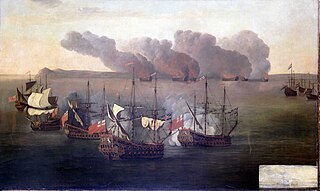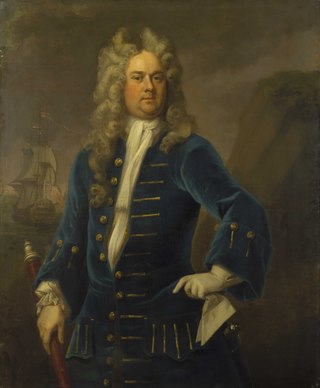
HMS Cornwall was an 80-gun, third rate, ship of the line built for the Royal Navy in the 1690s. She served in the War of the Grand Alliance, and in her first year took part in the Battle of Barfleur and the action at La Hougue.
Nonsuch was a 32-gun fourth-rate of the English Navy, built by Peter Pett I at Deptford Dockyard and launched in 1646. She was in the Parliamentary force during the English Civil War, then the Commonwealth Navy and was incorporated into the Royal Navy after the Restoration in 1660. During her time in the Commonwealth Navy she partook in the Battles of Krntish Knock, Portland and Gabbard. She was wrecked at Gibraltar on 3 December 1664.
Sapphire was a 38-gun fourth-rate of the Commonwealth of England. After commissioning she was actively involved in the First Anglo-Dutch War, participating in most major fleet actions. During the Second Anglo-Dutch War, she was only in the first two engagements then spent her time in Irish Waters and the Mediterranean. She was run ashore due to a pending attack by suspected Algerian pirates on Sicily in March 1670.

HMS Centurion was one of six 40-gun fourth-rate frigates, built for the Commonwealth of England under the 1650 Programme, she would be transferred to the navy of the Kingdom of England upon the Restoration of the monarchy in May 1660. When commissioned she partook in the First Anglo-Dutch War. After the first war ended she was in the Mediterranean fighting the Algerines at the Battle of Santa Cruz. She fought the battles of Dover, Portland, the Gabbard, and Scheveningen. During the Second Anglo-Dutch War she partook in the battles of Lowestoft and Orfordness. Following the second war she spent her time either in North America or the Mediterranean. She was wrecked in a storm in December 1689.

Foresight was a 40-gun fourth-rate of the Commonwealth of England, after the Restoration of the monarchy in 1660 she was incorporated into the Navy of the Kingdom of England. During her time in the Commonwealth Navy she partook in the First Anglo-Dutch War being present in the battles of Dungeness, Kentish Knock, Portland, The Gabbard and Scheveningen. She was also present at the Battle of Santa Cruz and the bombardment of Porto Farina, In the Second Anglo-Dutch War she was involved in the Battle of Vagen and the St James Day Fight. During the Third Anglo-Dutch War she participated in the battles of Schooneveld and Texel. For the remainder of her career she was in the West Indies, the Mediterranean and North American waters. She was wrecked south of Cuba in July 1698.
HMS Assistance was one of six 40-gun fourth-rate frigates, built for the Commonwealth of England under the 1650 Programme, after the Restoration of the monarchy in 1660 she was incorporated into the navy of the Kingdom of England. During her time in the Commonwealth Navy she partook in the First Anglo-Dutch War being present in the battles of Kentish Knock, Portland and The Gabbard. In the Mediterranean she was present at the Battle of Santa Cruz and the bombardment of Porto Farina, In the Second Anglo-Dutch War she was involved in the Battle of Lowestoft, Battle of Vagen and the St James Day Fight. She did not participate in fleet actions after this. She spent the rest of her service life undergoing several rebuilds and plying the waters as a cruiser protecting British trade and projecting British sovereignty. After nearly 95 years of Service she was sunk as a break water at Sheerness at the end of 1745.
Laurel was a 48-gun fourth-rate of the navy of the Commonwealth of England. She participated in almost all major Fleet Actions of the First Anglo-Dutch War. She was an active participant in the battles of Kentish Knock, Dungeness, Portland, The Gabbard and Scheveningen. She went to the west Indies with Admiral William Penn. She was wrecked in May 1657.
Yarmouth was a 44-gun fourth-rate frigate of the English Royal Navy, originally built for the navy of the Commonwealth of England at Great Yarmouth under the 1652 Programme, and launched in 1653. By 1666 her original armament of 44 guns had been increased to 52 guns by the addition of smaller cannon (sakers) on the quarterdeck, and by 1677 she carried 54 guns.
HMS Anne was a 70-gun third rate ship of the line of the English, built under the 1677 Construction Programme by Phineas Pett II at Chatham Dockyard during 1677/78. She fought in the War of English Succession 1688 to 1697. She fought in the Battle of Beachy Head where she was severely damaged and ran aground. She was burnt by the English to avoid capture by the French. The wreck is a Protected Wreck managed by Historic England.
HMS Deptford was a 50-gun fourth-rate ship of the line of the Royal Navy, launched at Woolwich Dockyard in 1687. This was the second of three 50-gun ships ordered in 1682/3.
HMS St Albans was a 50-gun fourth rate ship of the line of the English Royal Navy, launched at Deptford Dockyard in 1687. One of only three 50-gun ships to be built during James II's brief reign, she was first commissioned on 22 October 1688 under Captain William Constable, and joined Lord Dartmouth's fleet in that month. The ship fought in the Battle of Bantry Bay on 1 May 1689, at the capture of a French 36-gun ship on 18 July 1690 off Rame Head and in the Battle of Barfleur on 24 May 1692 and in the Battle of Placentia, Newfoundland on 16–21 September 1693.
HMS Gloucester was a 60-gun fourth rate ship of the line built for the Royal Navy during the 1690s. She spent most of her career in the West Indies and participated in the 1701–15 War of the Spanish Succession. The ship was hulked in 1708 and broken up in 1731.

HMS Chatham was a 50-gun fourth rate ship of the line of the Royal Navy, the first of five such ships to be ordered in 1690. The Chatham was built by Master Shipwright Robert Lee at the eponymous dockyard, and launched on 20 October 1691. She was designed to the same lines as Lee's previous 50-gun ship, the Sedgemoor of 1687 - her specification was for a length of 123 ft, breadth of 34ft 3in and depth in hold of 13ft 9in, although she measured very slightly more on completion.
HMS Southsea Castle was a 32-gun fifth rate built at Deptford Dockyard in 1694/95. She was assigned to the West Indies. She was wrecked along with HMS Bideford on Hispaniola in November 1699.
The 1693 Programme of fifth rates were derived from the 1689 Programme vessels as demi-batterie ships. The concept was to have one tier of ordnance flush on the upper deck for use in all weathers on a freeboard of at least seven feet. The ordnance would be arranged with a minimum of ten gun ports on the upper deck. The lower deck would be provided with four ports for heavier guns that could only be used in calm weather. For added propulsion ten oar ports per side would be provided with a central loading port. Four 32-gun vessels to these specifications were ordered in early 1693 with three to be built by Contract and one in dockyard.
The 1650 Programme of six 510 ton Fourth Rate vessels was initiated by the Council of State on 16 November 1649. On 2 January 1650 the Admiralty Committee confirmed that six 'frigrates' had been ordered at a cost of 6.10.0d per ton. The ships would be built under contract with the exception of one ship built in Dockyard. The ships were all named by 16 August 1650 and launched by the end of the year. Each ship was to carry initially 34 guns and 150 men. This would increase over time
HMS Portsmouth was a 34-gun fourth-rate of the English Navy, built by Thomas Eastwood at Portsmouth Dockyard and launched in 1649. She was incorporated into the Commonwealth Navy in 1650. She partook in the Battle off Dover and Kentish Knock in 1652, the Gabbard and Scheveningen in 1653. After the Restoration she was incorporated into the Royal Navy. She was present at the Battle of Lowestoft (1665) and the Four Days Battle. She was present at the Texel in 1673, the Battle of Bantry Bay in 1689. She was captured by the French in August 1689 and blown up.
HMS Fowey was a 32-gun fifth rate built by Mr. Flint of Plymouth in 1695/96. She was employed in trade protection and counter-piracy patrols in Home Waters and North America. She was in on the capture of a 50-gun Frenchman while returning from Virginia. She was taken by the French off the Scilly Islands in August 1704.
HMS Southsea Castle was a 32-gun fifth rate built under contract by John Knowler of Redbridge (Southampton) in 1695/96.
With the ascension of Queen Anne to the throne of England, these would be the first vessels associated to her reign. The vessels would be similar to the previous 1694 programme with one exception. The upper deck battery would be fully enclosed with a deck running from the foc's'le to the quarterdeck. This would protect the gunners and battery during an action with the enemy. In 1702 one vessel was ordered from dockyard. In 1703 two more were ordered from dockyard.


